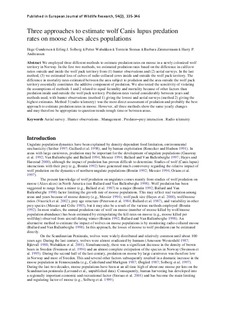Three approaches to estimate wolf Canis lupus predation rates on moose Alces alces populations
Gundersen, Hege; Solberg, Erling J.; Wabakken, Petter; Storaas, Torstein; Zimmermann, Barbara; Andreassen, Harry Peter
Peer reviewed, Journal article
Permanent lenke
http://hdl.handle.net/11250/134148Utgivelsesdato
2008Metadata
Vis full innførselSamlinger
Originalversjon
Gundersen, H., Solberg, E.J., Wabakken, P., Storaas, T., Zimmermann, B., Andreassen, H.P. (2008) Three approaches to estimate wolf Canis lupus predation rates on moose Alces alces populations. European Journal of Wildlife Research, 54(2), 335-346Sammendrag
Abstract We employed three different methods to estimate predation rates on moose in a newly colonized wolf territory in Norway. In the first two methods, we estimated predation rates based on the difference in calf/cow ratios outside and inside the wolf pack territory from (1) hunter observations and (2) aerial surveys. In the last method, (3) we estimated loss of calves of radio-collared cows inside and outside the wolf pack territory. The difference in mortality rates estimated between the area subject to predation and the area outside the wolf pack territory essentially constitutes the additive component of predation. We also tested the sensitivity of violating the assumptions of methods 1 and 2 related to equal fecundity and mortality because of other factors than predation inside and outside the wolf pack territory. Predation rates varied considerably between years and methods used, with hunter observations (method 1) giving the lowest and aerial surveys (method 2) giving the highest estimates. Method 3 (radio telemetry) was the most direct assessment of predation and probably the best approach to estimate predation rates in moose. However, all three methods show the same yearly changes and may therefore be appropriate to question trends trough time or between areas.
